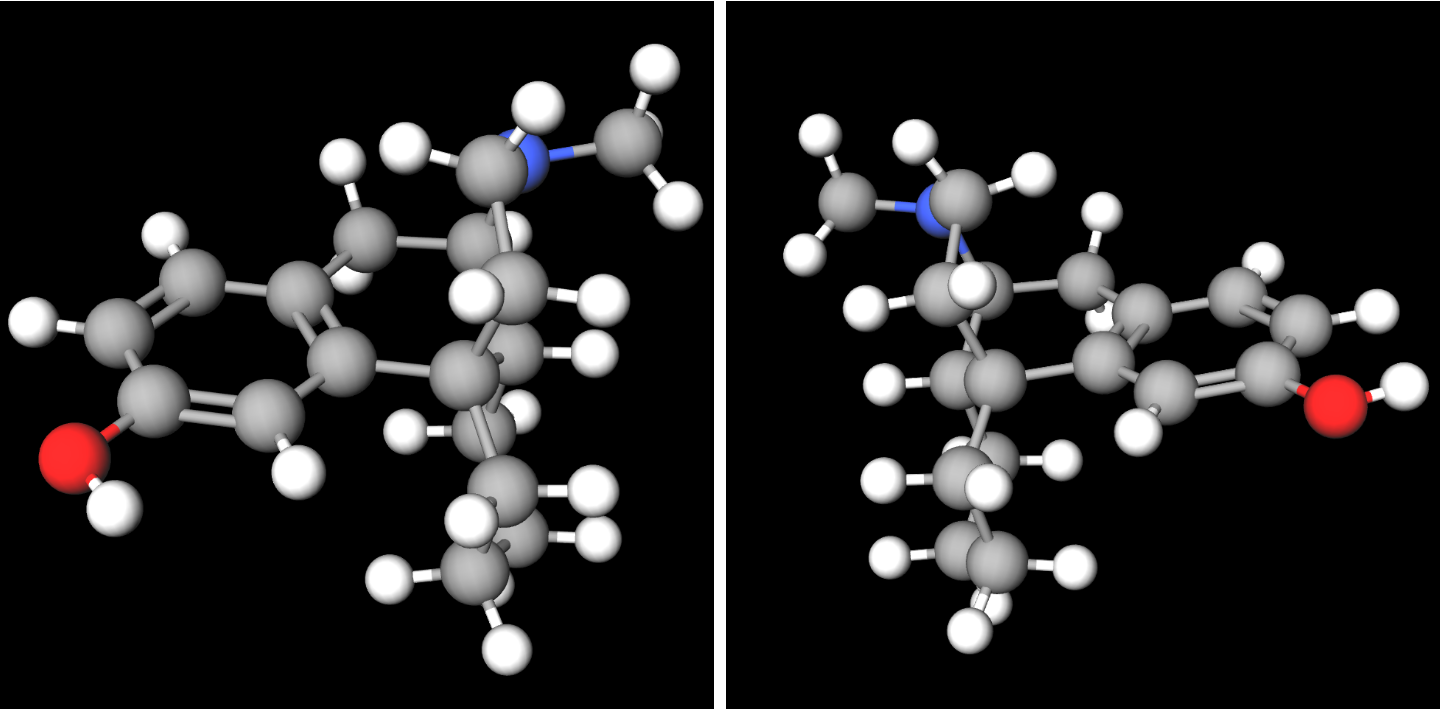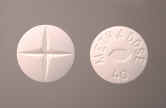|
Levorphanol
Levorphanol (brand name Levo-Dromoran) is an opioid medication used to treat moderate to severe pain. It is the levorotatory enantiomer of the compound racemorphan. Its dextrorotatory counterpart is dextrorphan. It was first described in Germany in 1946. The drug has been in medical use in the United States since 1953. Pharmacology Levorphanol acts predominantly as an agonist of the μ-opioid receptor (MOR), but is also an agonist of the δ-opioid receptor (DOR), κ-opioid receptor (KOR), and the nociceptin receptor (NOP), as well as an NMDA receptor antagonist and a serotonin-norepinephrine reuptake inhibitor (SNRI). Levorphanol, similarly to certain other opioids, also acts as a glycine receptor antagonist and GABA receptor antagonist at very high concentrations. As per the World Health Organization, levorphanol is a step 3 opioid and is considered eight times more potent than morphine at the MOR (2 mg levorphanol is equivalent to 15 mg morphine). Relative t ... [...More Info...] [...Related Items...] OR: [Wikipedia] [Google] [Baidu] |
Opioid
Opioids are a class of Drug, drugs that derive from, or mimic, natural substances found in the Papaver somniferum, opium poppy plant. Opioids work on opioid receptors in the brain and other organs to produce a variety of morphine-like effects, including analgesic, pain relief. The terms "opioid" and "opiate" are sometimes used interchangeably, but the term "opioid" is used to designate all substances, both natural and synthetic, that bind to opioid receptors in the brain. Opiates are alkaloid compounds naturally found in the opium poppy plant ''Papaver somniferum''. Medically they are primarily used for pain relief, including anesthesia. Other medical uses include suppression of diarrhea, replacement therapy for opioid use disorder, and Cold medicine, suppressing cough. The opioid receptor antagonist naloxone is used to reverse opioid overdose. Extremely potent opioids such as carfentanil are approved only for Veterinary medicine, veterinary use. Opioids are also frequently use ... [...More Info...] [...Related Items...] OR: [Wikipedia] [Google] [Baidu] |
Dextrorphan
Dextrorphan (DXO) is a psychoactive drug of the morphinan class which acts as an antitussive or cough suppressant and in high doses a dissociative hallucinogen. It is the dextrorotatory enantiomer of racemorphan; the levorotatory enantiomer is levorphanol. Dextrorphan is produced by O-demethylation of dextromethorphan by CYP2D6. Dextrorphan is an NMDA antagonist and contributes to the psychoactive effects of dextromethorphan. Pharmacology Pharmacodynamics The pharmacology of dextrorphan is similar to that of dextromethorphan (DXM). However, dextrorphan is much more potent as an NMDA receptor antagonist and much less active as a serotonin reuptake inhibitor, but retains DXM's activity as a norepinephrine reuptake inhibitor. It also has more affinity for the opioid receptors than dextromethorphan, significantly so at high doses. Pharmacokinetics Dextrorphan has a notably longer elimination half-life than its parent compound, and therefore has a tendency to accumulate ... [...More Info...] [...Related Items...] OR: [Wikipedia] [Google] [Baidu] |
Neuropathic Pain
Neuropathic pain is pain caused by a lesion or disease of the somatosensory nervous system. Neuropathic pain may be associated with abnormal sensations called dysesthesia or pain from normally non-painful stimuli (allodynia). It may have continuous and/or episodic (paroxysmal) components. The latter resemble stabbings or electric shocks. Common qualities include burning or coldness, "pins and needles" sensations, numbness and itching. Up to 7–8% of the European population is affected by neuropathic pain, and in 5% of persons it may be severe. The pain may result from disorders of the peripheral nervous system or the central nervous system (brain and spinal cord). Neuropathic pain may occur in isolation or in combination with other forms of pain. Medical treatments focus on identifying the underlying cause and relieving pain. In cases of peripheral neuropathy, the pain may progress to insensitivity. Diagnosis Diagnosis of pain conditions relies on the character of the pain w ... [...More Info...] [...Related Items...] OR: [Wikipedia] [Google] [Baidu] |
Nociceptin Receptor
The nociceptin opioid peptide receptor (NOP), also known as the nociceptin/orphanin FQ (N/OFQ) receptor or kappa-type 3 opioid receptor, is a protein that in humans is encoded by the ''OPRL1'' (opioid receptor-like 1) gene. The nociceptin receptor is a member of the opioid subfamily of G protein-coupled receptors whose natural Ligand (biochemistry), ligand is the 17 amino acid neuropeptide known as nociceptin, nociceptin (N/OFQ). This receptor is involved in the regulation of numerous brain activities, particularly instinctive and emotional behaviors. Antagonists targeting NOP are under investigation for their role as treatments for depression and Parkinson's disease, whereas NOP agonists have been shown to act as powerful, non-addictive painkillers in non-human primates. Although NOP shares high sequence identity (~60%) with the ‘classical’ opioid receptors Μ-opioid receptor, μ-OP (MOP), Κ-opioid receptor, κ-OP (KOP), and Δ-opioid receptor, δ-OP (DOP), it possesses litt ... [...More Info...] [...Related Items...] OR: [Wikipedia] [Google] [Baidu] |
κ-opioid Receptor
The κ-opioid receptor or kappa opioid receptor, abbreviated KOR or KOP for its ligand ketazocine, is a G protein-coupled receptor that in humans is encoded by the ''OPRK1'' gene. The KOR is coupled to the G protein Gi/G0 and is one of four related receptors that bind opioid-like compounds in the brain and are responsible for mediating the effects of these compounds. These effects include altering nociception, consciousness, motor control, and mood. Dysregulation of this receptor system has been implicated in alcohol and drug addiction. The KOR is a type of opioid receptor that binds the opioid peptide dynorphin as the primary endogenous ligand (substrate naturally occurring in the body). In addition to dynorphin, a variety of natural alkaloids, terpenes and synthetic ligands bind to the receptor. The KOR may provide a natural addiction control mechanism, and therefore, drugs that target this receptor may have therapeutic potential in the treatment of addiction . There ... [...More Info...] [...Related Items...] OR: [Wikipedia] [Google] [Baidu] |
NMDA Receptor Antagonist
NMDA receptor antagonists are a class of drugs that work to receptor antagonist, antagonize, or inhibit the action of, the NMDA, ''N''-Methyl-D-aspartate receptor (NMDA receptor, NMDAR). They are commonly used as anesthetics for humans and animals; the state of anesthesia they induce is referred to as dissociative anesthesia. Several synthetic opioids function additionally as NMDAR-antagonists, such as pethidine, levorphanol, methadone, dextropropoxyphene, tramadol, and ketobemidone. Some NMDA receptor antagonists, such as ketamine, dextromethorphan (DXM), phencyclidine (PCP), methoxetamine (MXE), and nitrous oxide (N2O), are sometimes used as recreational drugs, for their dissociative, hallucinogenic, and euphoriant properties. When used recreationally, they are classified as dissociative drugs. Uses and effects NMDA receptor antagonists induce a state called dissociative drug, dissociative anesthesia, marked by catalepsy, amnesia, and analgesia. Ketamine is a favored anesthet ... [...More Info...] [...Related Items...] OR: [Wikipedia] [Google] [Baidu] |
Serotonin Transporter
The serotonin transporter (SERT or 5-HTT) also known as the sodium-dependent serotonin transporter and solute carrier family 6 member 4 is a protein that in humans is encoded by the SLC6A4 gene. SERT is a type of monoamine transporter protein that transports the neurotransmitter serotonin from the synaptic cleft back to the presynaptic neuron, in a process known as serotonin reuptake. This transport of serotonin by the SERT protein terminates the action of serotonin and recycles it in a sodium-dependent manner. Many antidepressant medications of the SSRI and tricyclic antidepressant classes work by binding to SERT and thus reducing serotonin reuptake. It is a member of the sodium:neurotransmitter symporter family. A repeat length polymorphism in the promoter of this gene has been shown to affect the rate of serotonin uptake and may play a role in sudden infant death syndrome, aggressive behavior in Alzheimer disease patients, post-traumatic stress disorder and depression ... [...More Info...] [...Related Items...] OR: [Wikipedia] [Google] [Baidu] |
Ketobemidone
Ketobemidone, sold under the brand name Ketogan (a mixture of ketobemidone and Spasmolytic A29) among others, is a powerful synthetic opioid painkiller. Its effectiveness against pain is in the same range as morphine, and it also has some NMDA-antagonist properties imparted, in part, by its metabolite norketobemidone. This may make it useful for some types of pain that do not respond well to other opioids. It is marketed in Denmark, Iceland, Norway. Until 2024 it was available in, but is now withdrawn in Sweden. It is used for severe pain. History Ketobemidone was first synthesized in 1942 by Eisleb and colleagues, at the laboratory of I.G. Farbenindustrie at Hoechst during the Second World War. The first study of it in humans was published in 1946, and it was introduced in clinical medicine shortly after. It was not in clinical use in the United States when the Controlled Substances Act 1970 was promulgated and was assigned to Schedule I with an ACSCN of 9628. As of 2013, no ... [...More Info...] [...Related Items...] OR: [Wikipedia] [Google] [Baidu] |
GABA Receptor Antagonist
GABA receptor antagonists are drugs that inhibit the action of GABA. In general these drugs produce stimulant and convulsant effects, and are mainly used for counteracting overdoses of sedative drugs. Examples include bicuculline, securinine and metrazol, and the benzodiazepine GABAA receptor antagonist flumazenil. Other agents which may have GABAA receptor antagonism include the antibiotic ciprofloxacin, tranexamic acid, thujone, ginkgo biloba, and kudzu Kudzu (), also called Japanese arrowroot or Chinese arrowroot, is a group of climbing, coiling, and trailing deciduous perennial vines native to much of East Asia, Southeast Asia, and some Pacific islands. It is invasive species, invasive in .... See also * GABAA receptor negative allosteric modulators External links * References Biochemistry {{nervous-system-drug-stub ... [...More Info...] [...Related Items...] OR: [Wikipedia] [Google] [Baidu] |
Phenylpiperidine
Phenylpiperidines are chemical compounds with a phenyl moiety (chemistry), moiety directly attached to piperidine. Of particular interest are a variety of chemical derivative, derivatives of 4-phenylpiperidine, which have pharmacology, pharmacological effects including morphine-like activity or other central nervous system effects. Some of the butyrophenone antipsychotics, including aceperone, bromperidol, haloperidol, moperone, and trifluperidol, as well as the related diphenylbutylpiperidine antipsychotic penfluridol, are also 4-phenylpiperidine derivatives. Certain other opioids, including alvimopan, loperamide, and diphenoxylate, are 4-phenylpiperidine derivatives as well. See also * Benzylpiperidine * Phenylpiperazine References 4-Phenylpiperidines Piperidines {{Heterocyclic-stub ... [...More Info...] [...Related Items...] OR: [Wikipedia] [Google] [Baidu] |
Methadone
Methadone, sold under the brand names Dolophine and Methadose among others, is a synthetic opioid used medically to treat chronic pain and opioid use disorder. Prescribed for daily use, the medicine relieves cravings and opioid withdrawal symptoms. Withdrawal management using methadone can be accomplished in less than a month, or it may be done gradually over a longer period of time, or simply maintained for the rest of the patient's life. While a single dose has a rapid effect, maximum effect can take up to five days of use. After long-term use, in people with normal liver function, effects last 8 to 36 hours. Methadone is usually taken by mouth and rarely by intramuscular, injection into a muscle or intravenous, vein. Side effects are similar to those of other opioids. These frequently include dizziness, Somnolence, sleepiness, nausea, vomiting, and Perspiration, sweating. Serious risks include opioid abuse and respiratory depression. Heart arrhythmia, Abnormal heart rhythm ... [...More Info...] [...Related Items...] OR: [Wikipedia] [Google] [Baidu] |




